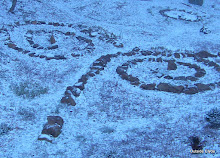I wasn't quite sure what it was when I bumped into it. So many plants in these parts look so much alike. I knew it had been weeded once already and wasn't safe where it was. Then dern if it didn't just jump right out of the ground while I was standing there. I brought it home. It seemed to need me.
Is it a Goat's Beard, Aruncus, a Black Cohosh, Actaea or could it be the native astilbe I was reading about the other day?
According to my reading the three lobed terminal leaf is the giveaway marking it as Astilbe biternata. There is plenty Black Cohosh and some Goat's Beard in the ridge top garden so I planned a closer inspection of them on this evening's stroll to be more assured of my ID.
What did I find? The plant I had always assumed was a Goat's Beard is another Astilbe biternata. It's common name is False Goat's Beard. I told you a lot of plants in these parts look a lot alike.
A piece of this had fallen out of the ground last year when I was borrowing some of the Rodgersia pinnata next to it. When it came up this spring it didn't look like the Goat's Beard I thought it was. I thought I had accidentally gotten a Black Cohosh. Well now it looks like it really is an Astilbe biternata. Confused yet?
It looks like I have two astilbe now and will still have to relocate some Goat's Beard and Black Cohosh which I don't have anymore like I thought I did.
I know where there is a real Goat's Beard growing on a log. At least I think it is unless the astilbe is making babies.
I'll probably have to give it a few more years, but at some point I will stick a shovel in this Fly Poison, Amianthium muscaetoxicum. A portion of it needs relocation. It's been getting bigger every year since it followed Sister #2 back to the mountain top.
Last week while I wasn't paying much attention the roadside vegetable garden exploded. The wildflowers are still trying to take over the east side strawberry patch and the ironweed is headed west big time.
I have never had such luxurious growth. It was always good, but not this good. It must be the dung
Now if all goes well and we avoid all the wilts, blights and mildew there could be bumper produce. Wish me luck. It has even been warm enough that my okra is stirring.
The self seeded sunflowers are back of course, bigger than ever. I should just give in and get me some red flowered ones.
Wednesday, June 25, 2014
Subscribe to:
Post Comments (Atom)













7 comments:
I think you're right-on with the Goat's beard idea...looks like one to me.
Could you take a pic of the Fly poison as it gets taller...is it on a stalk?
Danna the Fly Poison is in the lily family. It has a clump of very daylily like leaves and the flower comes up on a tall stalk held above the leaves.
Confused? Sure am! And sorrowful over the fact that my own astilbes bit the dust over the past couple of years.
Your veggies are looking WONderful. Hope you have the pleasure of a spectacular crop.
Red sunflowers? (Did I read that correctly?)
Yes Rebecca there are several colors of sunflowers including red. Many of them have multiple blooms on side branches to go with the main big flower at the top.
Astilbes can't tolerate dry and drought at all. I've watched some die in a garden down in town.
You grow okra? Oh yes, I forgot the Florida connection. I grow it too; Red Burgundy when I can find it. Good stuff.
I try to grow okra. I am hot challenged up here and the okra needs hot. I get one or two side dishes if I'm lucky. Sliced, stirred in olive oil, pepper and garlic salt, oven baked on a cookie sheet for 15 to 20 minutes, Ono!
Thanks for the info on fixing okra. Another way. Woohooo
Post a Comment